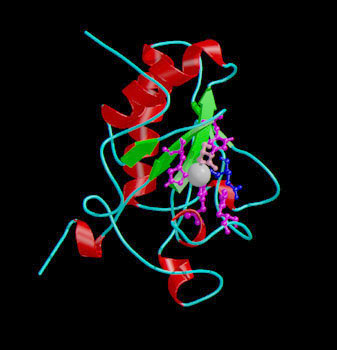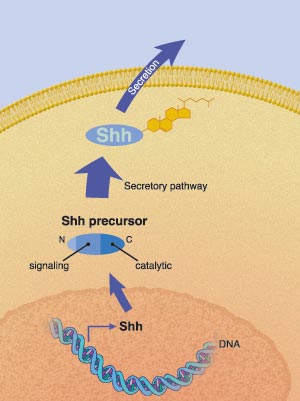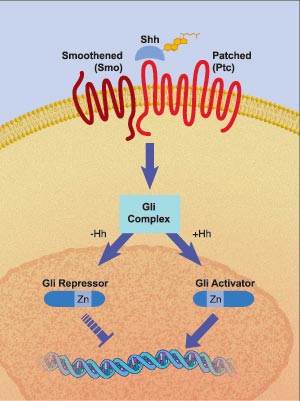This web page was produced as an assignment for an undergraduate course at Davidson College
Sonic Hedgehog
Purpose
The purpose of this page is to describe the protein Sonic Hedgehog (shh). Secondary goals include a discussion of mutants and a brief description of two shh homologues.
How Shh Got its Name
Sonic hedgehog is, in fact, named after the character from the popular Sega Genesis video game. The original hedgehog gene was found in Drosophila and was named for the appearance of the mutant phenotype which causes an embryo to be covered with pointy denticles resembling a hedgehog. The first two homologues of hedgehog were named after species of hedgehog and the third was named after the video game character (Gilbert, 2000).
What is Sonic Hedgehog?
Sonic Hedgehog is one of three homologues found in vertebrates. The hedgehog family consists of sonic hedgehog (shh), desert hedgehog (dhh), and indian hedgehog (ihh). Shh is the most common of the three and is therefore the best documented (Gilbert, 2000). Shh is made in the notochord of developing embryos. This important protein has many functions throughout the life of the organisms in which it is expressed. Below a few of these areas are described in detail.
How Shh Functions in Early Development
In the neural tube, the dorsal region is where the spinal neurons will get input from sensory neurons. The motor neurons reside in the ventral region. The embryonic development of the dorsal region is determined by signals coming from the epidermis, and the development of the ventral region is determined by signals, such as proteins, coming from the notochord. It is this ventral development stemming from the notochord that shh enters the scene. As shh is secreted from the notochord, a gradient is formed. Different levels of shh cause different types of cells to be formed in the developing embryo (Gilbert, 2000). Figure 1 describes how shh is secreted from the cell.
Figure 1: This cartoon depicts the process by which shh is secreted from cells in the notochord from transcription to secretion. The original protein product undergoes cholesterol-mediated cleavage. The amino-terminal portion is the active portion and is secreted from the cell following cleavage. These initially secreted proteins induce medial hinge cells to form the floor plate of the neural tube. The floor plate cells secrete more shh that will form the shh gradient throughout the developing embryo. This concentration signal will determine cell fates throughout the neural tube (Gilbert, 2000). Click on the image to view source.
Shh is a transcription regulating protein. It makes sense that a molecule involved in development would regulate transcription because cells are taking on specific characteristics during development based on which genes are transcribed. Shh affects two other genes that are part of the pathway through which shh functions (Gilbert, 2000). See Figure 2 for a more detailed explanation.
Figure 2: Shh interacts with two transmembrane proteins as it interacts with sells in the neural tube. They are Patched (ptc) and Smoothened (smo). Ptc actually binds with shh whereas smo is a signal transducer. In the absence of shh, ptc inhibits smo. The inhibition of smo actives a transcriptional repressor, and so transcription does not occur. When shh is present, it binds with ptc and so ptc cannot interfere with the functioning of smo. With smo uninhibited, other proteins are able to enter the nucleus that will cause transcription to be activated (Gilbert, 2000). Click on the image to view source.
Shh in Optic Development
Shh is involved in the separation of the single eye field into two bilateral fields. Although not proven, it is thought that shh emitted from the prechordal plate suppresses Pax6 which causes the eye field to divide into two. If the shh gene is mutated, the result is cyclopia, a single eye in the center of the face (Gilbert, 2000).
Other Important Roles of Shh


